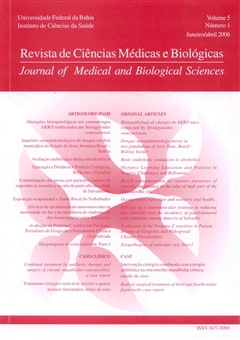Dengue seroepidemiology survey in two populations of Acre State, Brazil – Bolivia border
DOI:
https://doi.org/10.9771/cmbio.v5i1.4566Keywords:
Dengue, Seroepidemiology, State Acre-Brazil.Abstract
Serum samples from 320 inhabitants from the cities of Brasiléia and Epitaciolândia in Acre State (on the Brazil - Bolívia border) have been tested, using the ELISA method for IgM and IgG. These samples have been tested in the period after an epidemic of dengue in 2000 by serotypes DEN-1 and DEN-2. The prevalence of seropositivity for IgM was of 60.3% and 67.2% for IgG, and only 15% presented seronegativity. The positivity was most frequent among individuals of the male sex (70% IgM; 78.2% IgG), and also in the older ages (p < 0.0005). Among the individuals with no history of dengue, 62.2% and 66.7% presented IgM and IgG antibodies, respectively. The estimative of subnotification of such infection is on the order of 65% in Brasiléia and 9.9% in Epitaciolândia. In conclusion, the high prevalence of infection and the regional characteristics provide conditions for the introduction of new serotypes of dengue, which expose the population of such cities to the risk for the occurrence of dengue hemorrhagic fever.
Downloads
Downloads
Published
How to Cite
Issue
Section
License
The Journal of Medical and Biological Sciences reserves all copyrights of published works, including translations, allowing, however, their subsequent reproduction as transcription, with proper citation of source, through the Creative Commons license. The periodical has free and free access.


